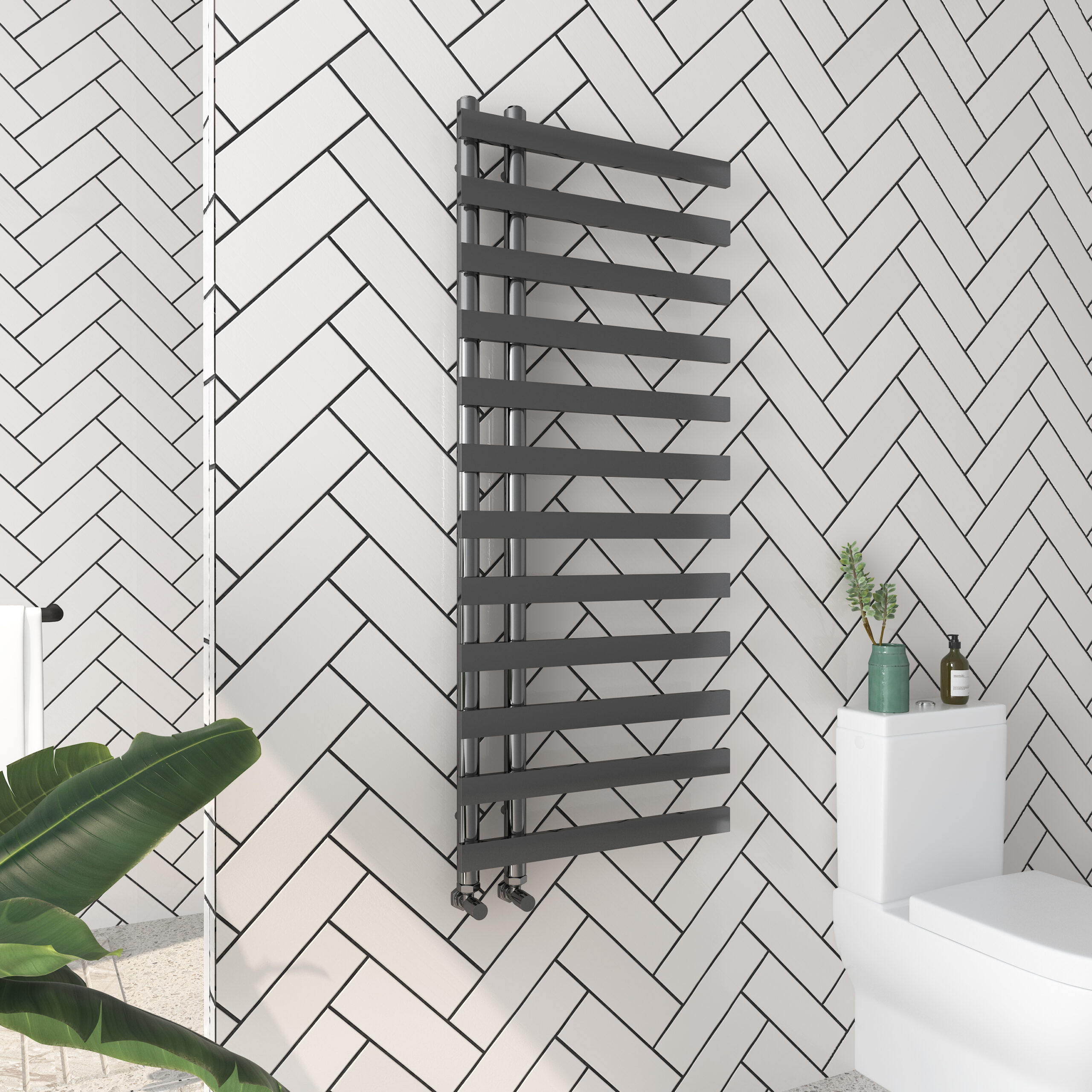Ultimate Tall Bathroom Radiators: The Best & Efficient Heat

Best Tall Bathroom Radiators for Maximum Heat and Style
Designer Radiator Showroom offers a wide range of tall bathroom radiators that are not only stylish but also highly efficient in heating your space. With their sleek lines and contemporary allure, these vertical radiators are perfect for modern UK homes. Our showroom at Unit G Grove Mill, Grove Park Industrial Estate, is open seven days a week, and our dedicated customer service team is available to assist you with any queries. Find energy grants for your home here
Contact us at 01257 452879 or find your perfect radiator here on our website.
The Physics of Heat: Horizontal vs Vertical Radiators
In the world of heating efficiency, the choice between horizontal and vertical radiators can have a significant impact on how effectively your space is heated. Let’s delve into the physics of heat and explore the advantages of each radiator orientation.
Traditionally, physics tells us that heat rises. This gives horizontal radiators an advantage in drawing in cold air at the bottom, heating it as it rises, and circulating the warmed air throughout the room. The horizontal surface area of these radiators allows for a larger heat exchange, making them efficient in delivering warmth.
On the other hand, vertical radiators may have less horizontal surface area, but they offer practical advantages that can’t be ignored. One major benefit is the reduced risk of airflow obstructions caused by furniture. Without obstructions, the vertical radiators can distribute heat more consistently throughout the room, ensuring that every corner is kept warm and comfortable.
Vertical radiators also provide a space-savvy solution in rooms where floor space is limited or oddly shaped. Their ability to fit snugly against the wall allows for efficient use of available space. Moreover, vertical radiators can become stylish focal points, adding an artistic touch to the room’s aesthetics.
Now, let’s summarize the advantages and disadvantages of each orientation in a clear and concise table:
| Horizontal Radiators | Vertical Radiators | |
|---|---|---|
| Advantages | Efficient heat distribution Large heat exchange surface area |
Consistent heat distribution Space-saving design Artistic focal point |
| Disadvantages | Prone to airflow obstructions May require more wall space |
Less horizontal surface area |
In conclusion, while both horizontal and vertical radiators have their advantages and disadvantages, it ultimately comes down to your personal preference and the specific requirements of your space. Consider factors such as available wall space, furniture placement, and design preferences when choosing between horizontal and vertical radiators. Whichever option you choose, ensure it meets the heating efficiency needs of your space for optimal comfort.
BTU: The True Measure of Warmth
Regardless of the orientation, the British Thermal Unit (BTU) is the true measure of warmth. As long as your chosen radiator meets the BTU requirements of your room, it will deliver the desired warmth, whether it’s vertical or horizontal.
It is important to accurately assess your room’s heat loss using a BTU calculator to determine the ideal BTU output for your radiator. This calculation takes into account factors such as room size, insulation, and desired temperature. By inputting these details into the calculator, you can ensure that your radiator has the appropriate heating capacity to keep your space comfortable.
Professional guidance from a heating expert can also be valuable when choosing the right radiator based on your specific needs and budget. They can provide insights on heating efficiency, radiator orientation, and other factors that may influence your decision.
Energy Saving Tips: Maximizing Efficiency
Maximize the efficiency of your radiator with these energy-saving tips:
- Bleed your radiators periodically to ensure optimal heat distribution.
- Insulate your walls and windows to prevent heat from escaping.
- Invest in a programmable thermostat to regulate heating based on your daily routine.
- Consider radiator reflector panels to prevent heat waste through exterior walls.
- Install thermostatic radiator valves to prevent overheating and save energy.
- Insulate your pipework to prevent heat loss.
Implementing these tips will help you keep your space cozy while saving energy.
Why Bleeding Your Radiators Matters
The process of bleeding your radiators involves releasing trapped air from the system. Over time, air can accumulate in the radiator, preventing it from heating up efficiently. Bleeding your radiators allows hot water to circulate freely, ensuring optimal heat distribution and enhancing radiator efficiency. It’s a simple task that can make a significant difference in the performance of your heating system.
“Bleeding your radiators is a crucial step in maximizing their efficiency and ensuring your home stays warm. It’s an easy DIY task that anyone can do.”
The Benefits of Insulation
Insulating your walls and windows can have a profound impact on your home’s energy efficiency. By minimizing heat loss, insulation helps your radiator work more effectively, reducing the need for constant heating. It creates a barrier that prevents cold air from entering and warm air from escaping, maintaining a comfortable temperature and reducing energy consumption.
“Proper insulation is essential for creating an energy-efficient home. By preventing heat from escaping, you can save on heating costs and reduce your environmental footprint.”
Smart Thermostats: Regulating Heat for Maximum Efficiency
Investing in a programmable thermostat allows you to control your heating system more efficiently. With a smart thermostat, you can set different temperature schedules based on your daily routine. It ensures the radiator operates only when needed, reducing energy waste and optimizing radiator efficiency. You can also remotely control the thermostat through a smartphone app, ensuring your home is warm and cosy whenever you need it.
“Smart thermostats provide the convenience of personalized heating schedules, allowing you to save money on energy bills without sacrificing comfort.”
Radiator Reflector Panels: Preventing Heat Waste
Consider installing radiator reflector panels behind your radiators to minimize heat loss through exterior walls. These panels reflect heat back into the room, preventing it from being absorbed by the wall. By reducing heat waste, reflector panels improve radiator efficiency and help maintain a consistent temperature in your space.
“Radiator reflector panels are a cost-effective solution to improve heating efficiency and keep your home warm. They can make a noticeable difference in reducing heat loss through exterior walls.”
Thermostatic Radiator Valves: Regulating Heat Output
Installing thermostatic radiator valves allows you to control the temperature of each radiator individually. These valves automatically adjust the flow of hot water based on the desired room temperature, preventing overheating and unnecessary energy consumption. By optimizing heat output, thermostatic radiator valves enhance energy efficiency and provide customized comfort.
“Thermostatic radiator valves offer precise control over room temperature, ensuring efficient heating and energy savings. They provide flexibility for different areas of your home, catering to individual preferences.”
Pipework Insulation: Minimizing Heat Loss
Insulating your pipework can significantly reduce heat loss and increase radiator efficiency. Exposed pipes can lose heat as the hot water flows through them, making your radiator work harder to maintain the desired temperature. By insulating the pipework, you minimize heat loss, allowing your radiator to operate more efficiently and saving energy in the process.
“Insulating pipework is a simple and effective way to improve radiator efficiency. It ensures that the hot water remains hot as it travels through the pipes, reducing heat loss and improving the performance of your heating system.”
Implementing these energy-saving tips will not only make your radiator more efficient but also help reduce your energy consumption and lower your heating bills. By taking these steps, you can enjoy a cosy home while making a positive impact on the environment.
Conclusion
In conclusion, tall bathroom radiators provide efficient heating solutions for modern UK homes. These stylish designs not only keep your space warm and cozy but also add a touch of elegance to your bathroom decor. Whether you choose a horizontal or vertical radiator, both orientations offer advantages depending on your specific needs.
Horizontal radiators are known for their ability to draw in cold air from the bottom, heat it up, and circulate it throughout the room. Meanwhile, vertical radiators provide practical benefits such as space-saving and design freedom, making them perfect for small or awkwardly shaped bathrooms.
It’s important to note that the orientation of the radiator does not significantly impact its heat output, as long as it meets the British Thermal Unit (BTU) requirements of the room. To ensure optimal warmth, accurately assess your room’s heat loss using a BTU calculator and consult a heating expert for professional guidance.
For efficient heating and energy savings, maximize your radiator’s efficiency by implementing energy-saving tips such as regular bleeding, proper insulation of walls and windows, and the use of programmable thermostats and thermostatic radiator valves. Designer Radiator Showroom offers a wide range of tall bathroom radiators with efficient heating capabilities and stylish designs, providing you with the perfect option to meet your heating needs.
FAQ
What are the advantages of tall bathroom radiators?
Tall bathroom radiators offer efficient heating solutions for modern UK homes. They are stylish, space-saving, and can fit snugly in small or awkwardly shaped rooms.
Do vertical radiators provide consistent heat distribution?
Yes, vertical radiators are less prone to airflow obstructions from furniture, allowing for more consistent heat distribution throughout the room.
Does the orientation of the radiator affect its heat output?
No, as long as the chosen radiator meets the British Thermal Unit (BTU) requirements of the room, the orientation (horizontal or vertical) does not significantly impact its heat output.
How can I maximize the efficiency of my radiator?
You can maximize the efficiency of your radiator by bleeding it periodically, insulating your walls and windows, investing in a programmable thermostat, considering radiator reflector panels, installing thermostatic radiator valves, and insulating your pipework.
Where can I find stylish tall bathroom radiators?
You can find a variety of stylish tall bathroom radiators at Designer Radiator Showroom.
Find energy grants for your home here
Visit our showroom at Unit G Grove Mill, Grove Park Industrial Estate or contact our dedicated customer service team at 01257 452879 to find your perfect radiator.




